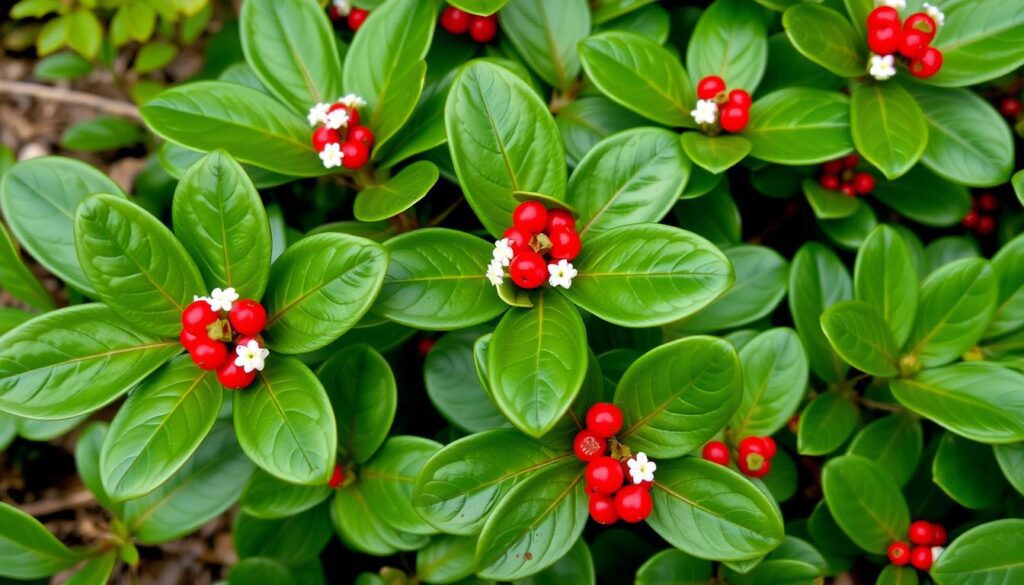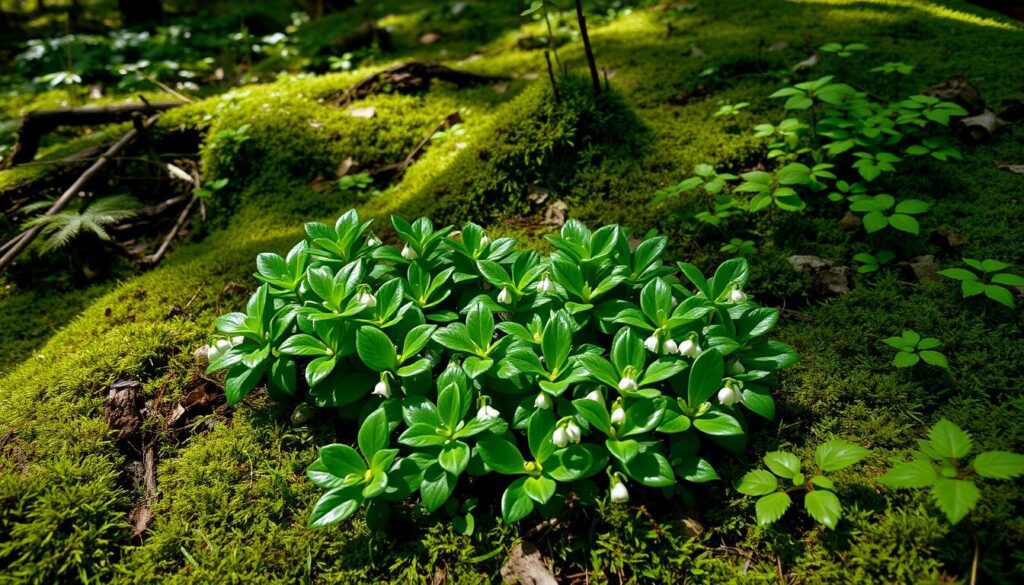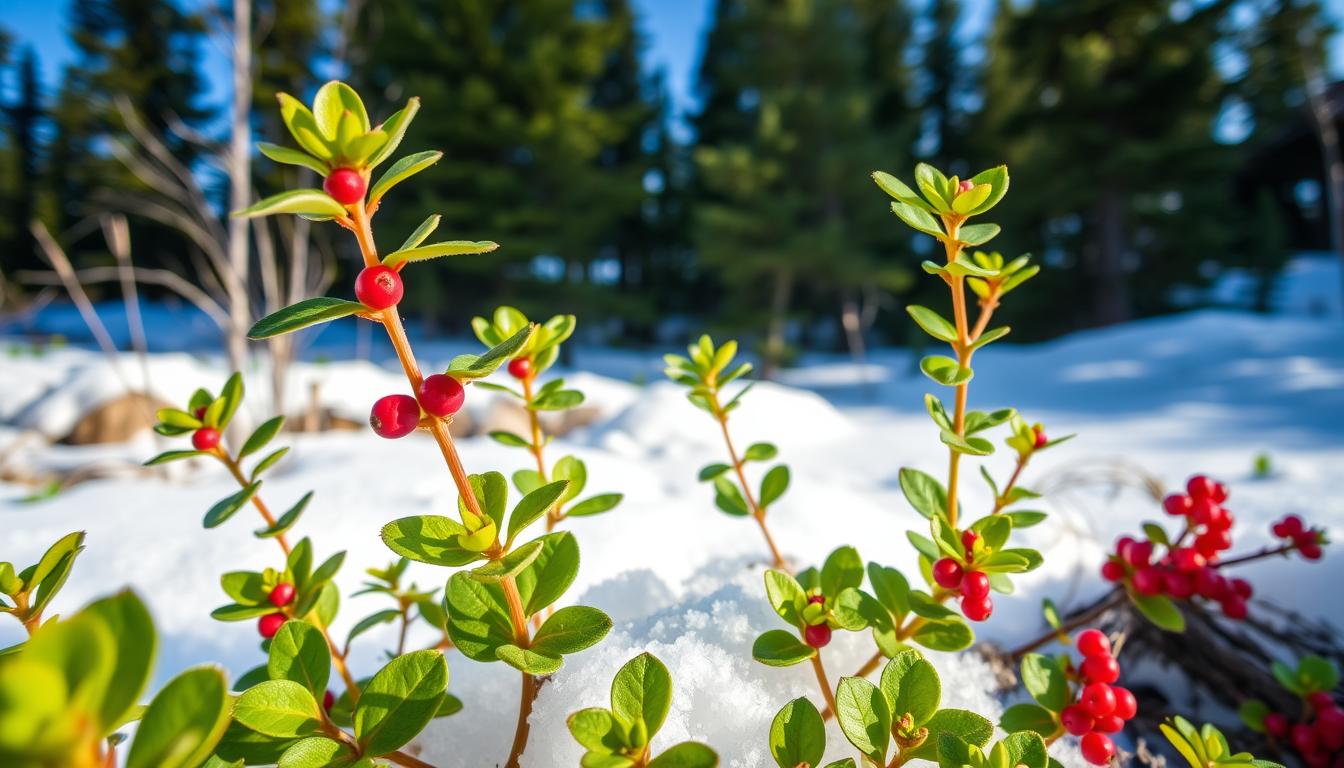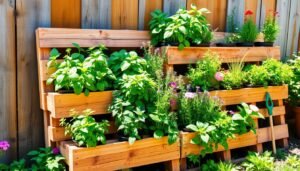is the wintergreen found in alaska edible ?Many nature lovers and foragers wonder if wintergreen in Alaska is safe to eat. You might know how these plants smell. Wintergreen, or Gaultheria procumbens, grows wild and is loved for its scent and berries. Learning about this plant can make you appreciate it more in Alaska’s nature and food.
Wintergreen in Alaska is not just tasty in food. It also has health benefits. As you learn about wintergreen, you’ll see its importance to Alaska’s people and plants. We’ll talk about eating wintergreen, its health perks, how to spot it, and how to pick it safely.
Table of Contents
Understanding Wintergreen Plants in Alaska
Wintergreen plants, especially Gaultheria procumbens, love Alaska’s cool weather. They stay green even under snow, showing they’re tough and adaptable. Learning about wintergreen plants reveals their importance in Alaska’s ecosystems and culture.
For centuries, Alaska’s Indigenous peoples have foraged wintergreen. They use it for medicine, showing a deep connection to the land. The leaves and berries are part of Alaska’s edible treasures.
Knowing where wintergreen grows is key to foraging responsibly. It’s best to pick only a small part of the plants you find. This keeps the plants healthy for everyone.
Here’s a table with important facts about wintergreen plants in Alaska:
| Characteristic | Description |
|---|---|
| Scientific Name | Gaultheria procumbens |
| USDA Hardiness Zones | 4 through 9 |
| Height | 2 to 12 inches |
| Leaf Retention | Evergreen |
| Flowers | White or pink |
| Fruit | Bright red berries |
What Are Wintergreen Plants?
Wintergreen plants, also known as Gaultheria procumbens, are small, evergreen shrubs. They grow low to the ground and thrive in many places. Their leaves are glossy and dark green, and they have bright red berries in late summer and early fall.
When you crush the leaves, they smell like menthol. This unique scent is what makes them special.
In Alaska, plants like Gaultheria hispidula and Lingonberry (Vaccinium vitis-idaea) add to the beauty of the boreal forests. These plants help create a home for many insects and small animals. They are also a key food source for wildlife during the cold winter months.
Wintergreen plants are also important for their healing properties. Gaultheria procumbens and similar plants have been used for centuries to relieve pain and reduce inflammation. In Alaska, people have used the leaves and berries of these plants for traditional medicine. This shows how valuable they are in both culture and nature. But, are these wintergreen plants in Alaska edible? It’s crucial to be careful when consuming them.

| Plant Species | Description | Common Uses |
|---|---|---|
| Gaultheria procumbens | Low-growing evergreen shrub with glossy leaves and red berries | Aromatic properties, medicinal uses |
| Gaultheria hispidula | Closely related species found in boreal forests of Alaska | Ground cover, wildlife food source |
| Vaccinium vitis-idaea | Wintergreen-like plant, commonly known as Lingonberry | Nutritional benefits, edible fruit |
Characteristics of Wintergreen Plants
Wintergreen plants belong to the family Pyrolaceae. They are easy to spot because of their unique traits. These evergreen perennials grow 4 to 6 inches tall and thrive in many places, like coniferous woods and damp rock ledges.

Their leaves are dark green and shiny, making them easy to identify. The small, round, bright red berries add a striking contrast to the leaves. From June to August, they bloom with small white or pink bell-shaped flowers.
Wintergreen plants like different soils, including sandy, loamy, and clay mixtures. They do well in mildly acidic to neutral pH levels. They grow best in cool, partially shaded areas. Their growth rate is slow to medium, and they need a special relationship with soil to grow well.
These plants are not threatened, showing they are common. Their leaves and fruit are used for medicine and food, but they are not very edible. This shows their importance in traditional practices.
Knowing these facts helps you appreciate wintergreen plants more. It connects you with nature as you spot these special plants in the wild.
| Characteristic | Details |
|---|---|
| Family | Pyrolaceae |
| Plant Height | 4 to 6 inches (0.1 m) |
| Flowering Season | June to August |
| USDA Hardiness Zones | 4-8 |
| Edibility Rating | 1 out of 5 |
| Medicinal Rating | 1 out of 5 |
| Native Range | Europe, North Asia, Japan, North America |
| Growth Rate | Slow to medium |
| Preferred Soil Types | Sandy, loamy, clay |
| Weed Potential | None |
Are Wintergreen Plants in Alaska Edible?
You might be curious if wintergreen plants in Alaska are safe to eat. The berries and leaves have unique tastes and can be eaten in small amounts. Knowing if they are edible helps you forage wisely.
Edibility of Wintergreen Berries
Wintergreen berries in Alaska taste sweet and minty. You can eat them raw or use them in foods like jams and desserts. They look good too, making them a hit with foragers.
Edibility of Wintergreen Leaves
Wintergreen leaves are different. They’re not poisonous but have a compound that can be harmful if eaten too much. People make tea from the leaves for a minty flavor. But, eating too much can cause problems. It’s important to know this to enjoy wintergreen plants safely.

Health Benefits of Wintergreen Plants
Wintergreen plants are known for their health benefits, making them popular in traditional medicine. They support both physical and mental health. Knowing their benefits can help you use them in your wellness routine.
Pain Relief
The medicinal properties of wintergreen are especially good for pain relief. It contains methyl salicylate, similar to aspirin, which helps with headaches and muscle pain. People have seen big improvements in their symptoms by using wintergreen-infused oils.
Digestive Health
Wintergreen plants also help with digestive health. Drinking tea made from wintergreen leaves can ease bloating and stomach issues. It’s a great remedy for digestive discomfort. Regular use can improve intestinal health and overall digestion.
Respiratory Support
Wintergreen’s natural anti-inflammatory properties are great for the lungs. Wintergreen tea can reduce congestion and make breathing easier. It helps with symptoms like coughs and colds.
How to Identify Wintergreen Plants in Alaska
Knowing how to spot wintergreen plants is key for safe foraging. Wintergreen (Gaultheria procumbens) grows 4 to 8 inches tall, forming a dense carpet. Its leaves are shiny, oval, and 1 to 2 inches long. They may turn purple in cold weather.
Crushing the leaves releases a minty scent, a clear sign of wintergreen. This smell is a big help in identifying them.

In summer, wintergreen plants have bright red berries, about pea-sized. These berries are known for their minty flavor. Wintergreen is special because it blooms and bears fruit at the same time.
These traits help you spot wintergreen plants in Alaska’s varied landscapes.
Foraging tips also mention the soil wintergreen likes. It thrives in acidic soil and can handle dry conditions once it’s established. Wintergreen can even grow in deep shade under conifers. This makes them tough in Alaska’s forests.
By looking closely at these features and following foraging tips, you can find wintergreen plants with confidence.
How to Safely Consume Wintergreen Plants
It’s important to know how to eat wintergreen plants safely. They are edible, but you need to be careful. This means knowing about wintergreen toxicity and how much to eat to stay safe.
Dosage Considerations
When you eat wintergreen, don’t overdo it. Eating a handful of wintergreen berries is usually okay. For tea, use only one or two leaves per cup. These steps help you enjoy wintergreen without risks.
Avoiding Toxicity
Wintergreen has a good compound called methyl salicylate. But too much can be harmful. This is especially true for kids and pets. Always make sure you know what wintergreen plant you’re picking.
Also, watch out for allergic reactions when trying wintergreen for the first time. If you notice any bad reactions, talk to a doctor. Being careful with wintergreen lets you enjoy its benefits safely.
How to Harvest Wintergreen Plants in Alaska
Foraging wintergreen safely is more than just finding the plant. It’s about harvesting in a way that protects the environment. This ensures the plant will be available for others in the future. The best time to pick wintergreen in Alaska is late summer for berries and leaves in late summer or early fall.
When you go to gather wintergreen, use scissors or pruning shears to cut the leaves. This method helps the plant grow back. It’s good to leave some of the plant behind. This keeps the ecosystem healthy.
| Harvesting Element | Optimal Time | Recommended Tool | Sustainability Tip |
|---|---|---|---|
| Wintergreen Berries | Late Summer | Scissors | Harvest 10% or less |
| Wintergreen Leaves | Late Summer to Early Fall | Pruning Shears | Leave part of the plant |
By following these sustainable steps, you can enjoy wintergreen while helping it thrive in the wild. This way, future generations can also benefit from it.
Cooking and Recipes with Wintergreen Plants
Wintergreen plants open up new culinary adventures. They add unique flavors to many dishes. Here are some ways to use wintergreen in your cooking:
- Wintergreen Berry Jam: Make a tasty jam with ripe wintergreen berries. It’s great on toast or with cheese.
- Infused Wintergreen Tea: Create a refreshing tea with young wintergreen leaves. Enjoy it hot or iced.
- Baked Goods: Add wintergreen berries to muffins or cookies. They bring a spicy flavor that’s perfect with sweet treats.
Wintergreen’s fruit has a strong, spicy taste, like germolene. It can make many dishes better. The raw leaves are great fresh or as tea. This lets you enjoy wintergreen in a unique way.
As you try out different wintergreen recipes, you’ll find new and exciting dishes. Your creativity can lead to amazing flavors.
Conclusion
Wintergreen plants in Alaska are safe to eat. They have leaves and berries that are good for you. You can use them in teas, jams, and more, enjoying their health benefits.
But, remember to eat wintergreen in small amounts. It has a compound called methyl salicylate that can be harmful if you eat too much.
It’s also important to know how to identify wintergreen plants. Knowing the USDA zones in Alaska helps you find them. This way, you can harvest them safely and help protect their home.
Wintergreen is not just tasty; it’s also good for your health. It can help with digestion, pain, and breathing. So, go ahead and try wintergreen, but do it in a way that’s good for the environment.




Pingback: Zebra Plant Care: Tips for a Thriving Houseplant
Pingback: Rattlesnake Plant Care: Tips for Thriving Houseplants